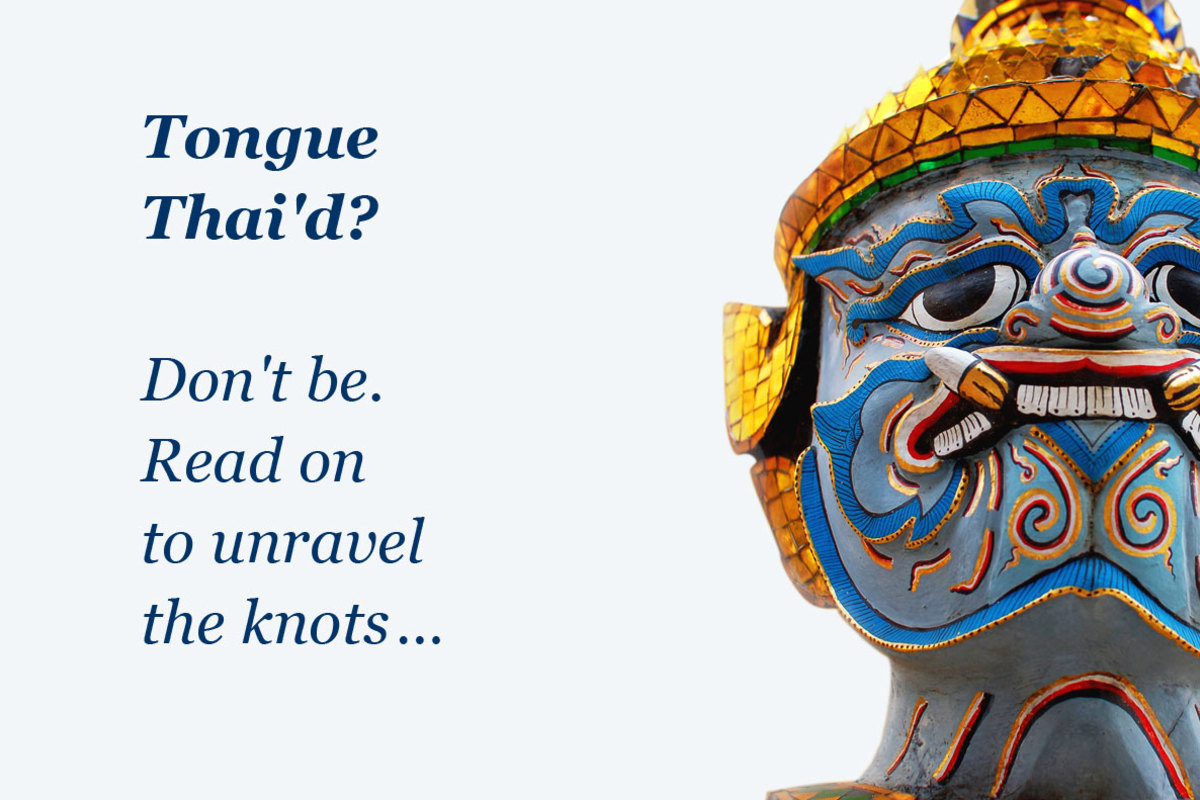The Thai Language – An Exercise in Flutility

For the visitor to Thailand even a casual acquaintance with Thai amply demonstrates how the concepts and values of Thai culture are reflected in the way the language is spoken. One of the first things you’ll notice is how being polite and respectful plays a crucial part in everyday conversation.
Male speakers, for example, typically add the word khráp at the end of a sentence or a question as a marker of politeness and respect. For female speakers khâ is added to statements and khá to questions. These words are also often used to show agreement or to merely show that you are listening attentively.
Thais value the ability to stay cool under pressure – to maintain a jai yen (a cool heart) at all times and they don’t appreciate it when fàràng (Caucasians) become angry and allow their jai ráwn (hot heart) to influence the way they speak. Adopting the Thai attitude of mâi pen rai (it doesn’t matter) when things don’t go quite according to plan will amply demonstrate that you understand the importance of not causing someone to sĭa nâa (lose face) and that you are showing due consideration for the feelings of others, krayng jai.
Thai is a tonal language. There are five of them - a high tone, a mid tone, a falling tone, a low tone and a rising tone. In most systems that use the Latin alphabet for transliterating Thai for foreign learners, diacritic marks are placed above the word to indicate the proper tone. Khráp, for instance is pronounced with a high tone and fàràng with two low tones.
Most speakers of non-tonal languages, like English, do in fact use all these five tones in speech as part of the sentence’s intonation, but the difference with Thai is that each individual word has a distinctive tone that potentially changes the meaning of the word. The word mái (high tone) means ‘wood’, mài (low tone) ‘new, again’ (as in Chiang Mai – ‘New City’) and mâi (falling tone) means ‘to burn’ and so on.
Mastering tones for many people seems an impossible task, but they are not really as difficult as you might imagine. The main problem for most speakers of non-tonal languages is that they are inclined to impose the intonation patterns of their mother tongue onto the tonal system of Thai. Try to remember that individual words carry tone and not the sentence. There are patterns that you have to imitate and initially at least the best way to do this is parrot fashion. Literally listen and repeat often until the pattern becomes fixed in your auditory memory. Start with short phrases and master these before moving on to more complex sentences.
One of the easiest ways to master the tones in Thai is to listen repeatedly to native speakers and imitate them as closely as you can. YouTube is an enormously helpful resource for learning tones THAI TONES. A musical ear is obviously advantageous here but remember that even if you fail utterly the chances are that Thais will likely be able to understand you by context. Language is not spoken in a vacuum and a great deal of what you are likely to say will be anticipated by the person you’re speaking to. And, as most of your dealings, at least as a tourist, will revolve around touristy things, any mistakes you make will be easily interpreted, and the Thais are remarkably tolerant and understanding with foreigners trying to make an effort to speak Thai.
Most foreigners begin by learning Standard Thai, sometimes called Central Thai, which is based on the educated register of the Ayutthaya dialect. More than half its vocabulary is derived from Old Khmer, Sanskrit, Pali, Mon, and, especially in Bangkok, a number of Chinese languages – none of which are linguistically related. It is the language of newspapers, schools and university, as well as public broadcasting. But a number of variant registers exist which can be quite different to the standard form. Street Thai is a much more lively and constantly changing register that reflects age, current trends and the influences of the people who use it. It is used between close friends and family and can be tricky for foreign learners to use naturally and without causing offence.
Politicians and public figures use Rhetorical Thai, which can sound very monotonous and somewhat unintelligible to the uninitiated, as is Religious Thai, used by monks and when addressing monks, and when talking about Buddhism. It is heavily influenced by Sanskrit and Pali. Royal Thai is a register you’re very unlikely to ever hear or need. It is used when you talk to members of the royal family or when talking about their activities. It is heavily influenced by Old Khmer. Most Thais of course speak all these registers and adjust their language according to the social context. To be on the safe side it is better for foreign learners to stick to a polite form of Standard Thai to avoid unintentionally giving offence, until their mastery of the language has reached a level where the subtle nuances of expression and awareness of linguistic context is close to native speaker levels.
Apart from Central Thai, there are quite a few regional dialects such as Khorat Thai, Soutwestern Thai, Upper Central Thai, etc, and a number of closely related languages such as Isan, Phuu Thai, Shan, Northern Thai, Southern Thai among others, and, of course Lao, the national language of Laos.
The Thai script is based on an Old Khmer script, which itself derives from a southern Indian Pallava script. Thai historical tradition credits the thirteenth-century King Ramkhamhaeng the Great as its creator. With 44 consonants, 15 vowels symbols that can combine to make 28 vowel forms, and four diacritic marks to indicate tone, the Thai writing system does indeed at first glance appear quite daunting, especially as Thai vowels may be written before, after, above and below a consonant or in a combination of positions. But, taken in stages, the Thai writing system is remarkably logical and far more phonetically accurate in rendering sounds than English orthography, which to most foreign learners seems to have as many exceptions as it has rules.
The Thai script is beautiful and elegant and flows from left to right, traditionally with no breaks between words. Again, there are a multitude of Thai fonts that can be hard to decipher but the standard from, once mastered, makes the process much easier.
In more recent times English has been the great provider of new vocabulary in Thai, though often the system of orthography used - there is no real standard orthography - makes it difficult to discern what word has been borrowed, but this can prove linguistically insightful and illuminating as a guide to Thai phonology – the way Thai organises its inventory of sounds, what combinations of sounds are possible or where they can occur, for example.
For instance, the word apple is rendered in Thai as aep pern, because the consonant ‘l’ cannot appear at the end of a word, so ‘n’, which is possible in word final-position, replaces it. Similarly, software is rendered phonetically in Thai Romanised orthography as sof wae, again because the Thais find an ‘f’ followed by a ‘t’ at the end of a word an impossibly difficult consonant cluster and so omit the final ‘t’. The list of words borrowed from English reflects the modernization of Thailand that began in the nineteenth century, and like much in Thai culture reflects the Thai willingness to incorporate and adapt the new to its own ends.
Although this sometimes produces neologisms that to non-Thai ears sometimes sound vaguely comical, it’s worth remembering that English over the centuries has borrowed thousands of words, and forced them into conformity with English orthographic conventions that in many instances would cause the original owners a wry smile or two.
Your efforts at learning Thai will be richly rewarded. It is a mellifluous, fluting language with a long and treasured history which Thais feel a genuine respect for and take a delight in using deftly in all its various forms. In the land of smiles a little goes a long way.










of collaborative energy




Before proceeding to use the website please carefully ready our Terms and Policies
I accept Diwerent's Terms and Conditions and Privacy Policy













